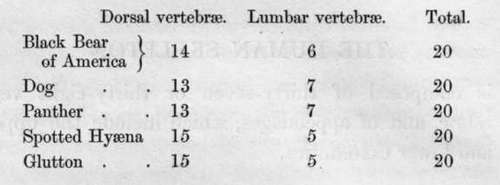The Human Skeleton
Description
This section is from the book "The Homologies Of The Human Skeleton", by Holmes Coote. Also available from Amazon: The Homologies of the Human Skeleton.
The Human Skeleton
The Human Skeleton is composed of thirty-seven or thirty-eight vertebrae, and of appendages, which include the upper and lower extremities.
There are 4 cranial vertebrae; the nasal; the frontal; the parietal; the occipital, 7 cervical vertebrae, 12 dorsal vertebrae, 5 lumbar vertebrae, 5 sacral vertebrae, 4 or 5 coccygeal vertebrae.
The number of the cranial and of the cervical vertebrae remain the same, with but two exceptions,* throughout the mammalian class; but the number of the dorsal vertebrae, or of those vertebrae from which long pleurapophyses, or ribs, arch forwards, varies in different animals, so as to give as much support to the viscera as is compatible with the proper mobility of the trunk. In most Carnivora the number of the dorsal and lumbar vertebrae united is the same, although the number of the movable ribs, and consequently of the dorsal vertebrae, varies considerably, as the following examples will shew.
* The three-toed sloth has nine cervical vertebrae, and the manati has but six.

As it is for many reasons more convenient to reserve the account of the cranial vertebrae for subsequent consideration, we will commence with the description of the cervical vertebrae.
Continue to:
